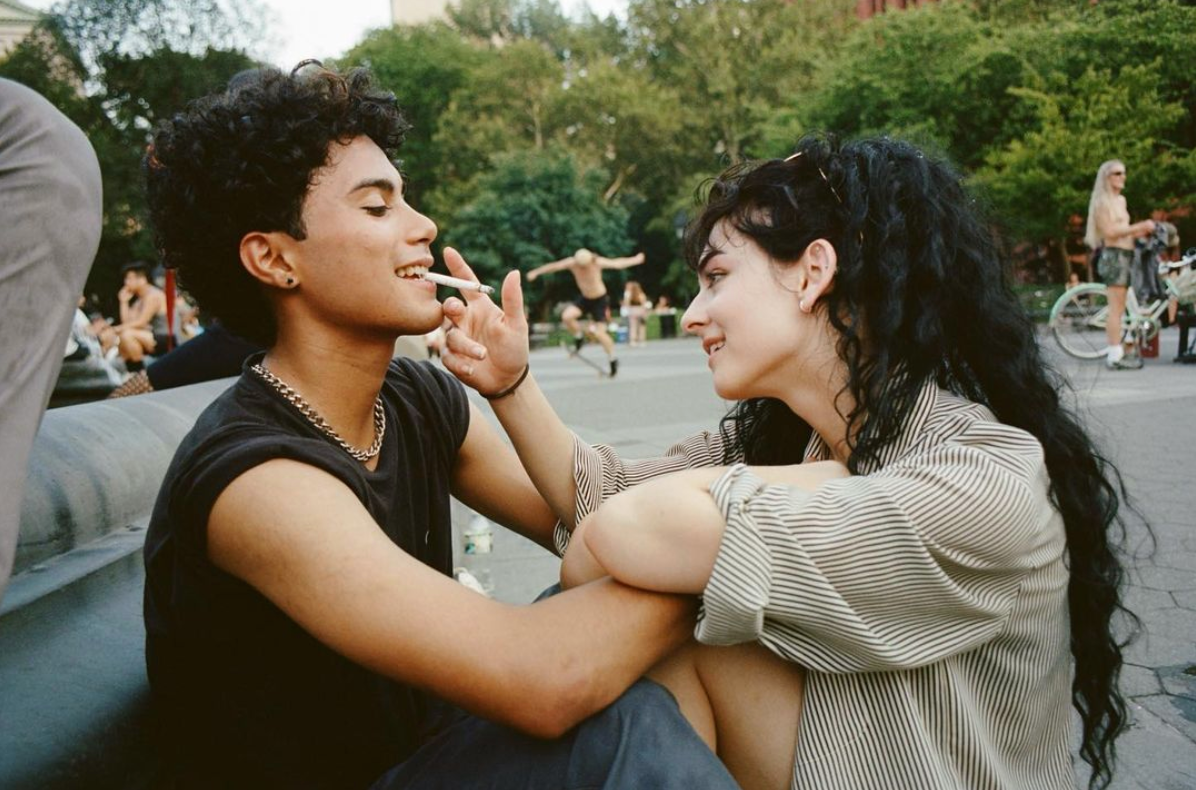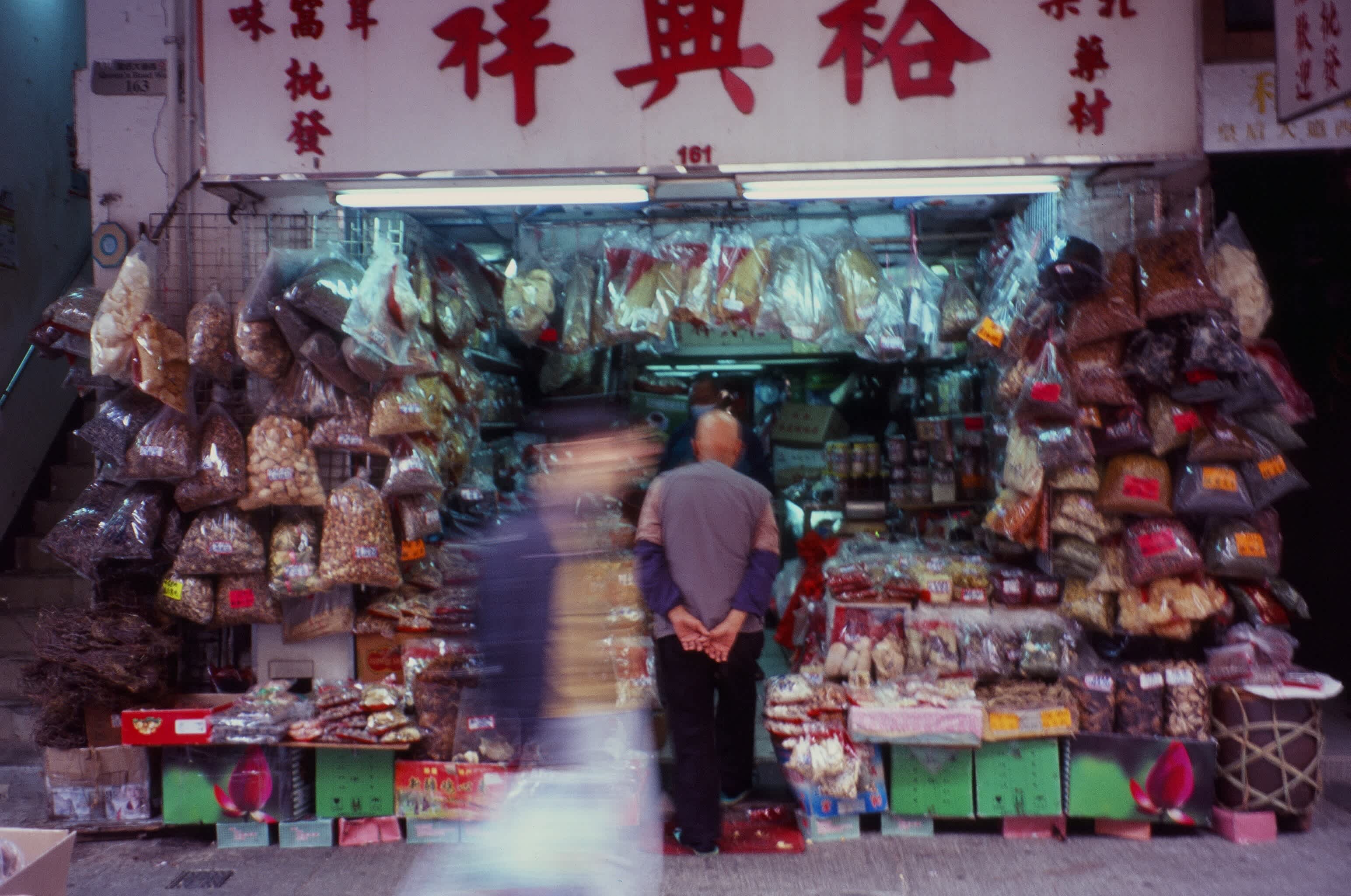
You’ll want to know Sarah Elise Abramson.
In one of her self-portraits, she squats with an orange to her chin, perched with her arms and knees crossed in front of her, but her face looking out at the camera. That gaze lingers, like she says she does when she comes across a pretty flower on an in-and-out trip to the post office.
Before we even sit down for our interview, she gives me a hug and a tour of her house, shared with roommates and very open, with a big window and a balcony on which they spend a lot of time together. You can just tell. What walls and surfaces there are, are covered in art and photographs, things she and her roommates have acquired or taken. On the doorframe of her bedroom, she says, is her favorite photo ever: her grandparents when they were young.
Abramson’s personal style is everyday surrealism that leaves its viewers at the intersection of poetry and intense physicality. Below, the photographer/painter/curator/writer/editor tells us how she achieves that mood, working with just Polaroids and film.
Q: When did you start photography?
Sarah: They don’t offer middle schoolers photography classes, but I knew that’s what I wanted to do. So, I begged my mom at 11 to sign me up for an adult photography class. She’d just come with me and sit in the corner and read her book. That’s where I learned about F-stop, aperture, shutter speed, and all the basics. It came naturally— which isn’t a ton of other things in my life. We went and shot at the botanical gardens (me and all these other middle aged people). That was the first time we used all the techniques I’d been learning. It was all analog. I use the same camera now. It’s all manual, so you have to use your brain to figure out the exposure which I think is paramount if you want to call yourself a photographer. If you just rely on light meters, you’re not really considering everything because light meters can only tell you so much. It’s just part of it.

Q: What made you interested in photography?
Sarah: Honestly, I don’t know. I think my parents just bought me a cheap camera, and I started messing around with it. I get distracted really easily, so being forced to look through a lens narrows the world down for me. I’m able to hone in on more of what I’m trying to show or say.
Q: What did you shoot mostly as a kid?
Sarah: Mostly nature. In high school, I started shooting my friends sort of similarly to how I do today. I just found this really old picture that I printed in the darkroom in high school of a friend. It’s just her in a mirror, and I use mirrors a lot. So it was like “Whoa I was even doing that back then and I didn’t realize it.”
Q: Is your work all film?
Sarah: Yep, Polaroid, all 35mm. Sometimes 4x5 but I haven’t used that in a while.
Q: What was your college experience like?
Sarah: I decided I didn’t want to go to New York like I once thought. It’s too fast-paced. I took a tour of the campus at Brooks, and it was so beautiful. It’s in Santa Barbara. I had also recently fallen super in love with my future ex-husband. He is still one of the most amazing people I’ve ever met. I met him right after I graduated high school, and that also influenced me not to go to New York. Anyway, yeah so I got married at 20 and then divorced at 22. I don’t regret it, but it’s just weird to think that I used to be married.
I ended up going to Brooks, which was a really poor choice for me because they’re a very commercial school, and I’m not. So, all my classmates loved my work and all my professors didn’t.

Q: I’ve been reading the book “How Music Works” by David Byrne. In it he says, “I believe that we unconsciously and instinctively make work to pre-existing formats.” Thoughts?
Sarah: Well, I’m confused what he means by pre-existing formats. Does he mean other work being made?
Well, he talks about how environment and experience influence your perspective. He says creativity is often romanticized as something that comes strictly from within, but that that’s likely not a realistic version of creativity.
Sarah: Oh, well absolutely. I’m sure it works differently for all artists, but I’m definitely influenced by my surroundings, what’s happening currently in my life. For example, for a while—and sorta still— I got into posing my models with their hands around their neck. Then, one of my good friends Mel Baker brought that up to me and was like “Are you doing this for a reason?” and I hadn’t even realized I’d been doing it. She was like “I thought you were doing it intentionally. Maybe you were trying to express that you felt suffocated.” Which I definitely did. I was like whoa that’s so crazy that that came out in my work, and I wasn’t even fully conscious of it. Also, the people that you surround yourself with affect your work. Especially in my work because I shoot my friends, and I call all of my shoots collaborations because it’s not just me doing everything. It’s being able to articulate the feeling I want expressed to someone else so they understand it too. I want to start directing short films and feature length films, so I think it’s really important to know how to communicate with your collaborators.
Q: How would you describe the style of your work?
Sarah: Everyday surrealism. Analog, contemporary, fine art. I like to incorporate nature, especially places that look like heterotopias which is a concept that Foucault elaborated on. The Wikipedia definition is the space in which a phone call exists, the space when you look at yourself in the mirror. All the other examples are basically these placeless places. They’re very specific. So, in a lot of my work, I try to have my models in places that look like they could be anywhere and any era.

Q: How do you feel your style has changed over time?
Sarah: I feel like it’s changed a lot and also hasn’t. I’m still attracted to the same sort of things and the same sort of feelings I was at age 11. Everything is just much more refined now.
Q: Did you have any influences?
Sarah: I’ve been really lucky to have pretty amazing photo mentors. Ahndraya Parlato was my first sort of one. I’m obsessed with her work. We started emailing, I’d send her my work, and she’d give me feedback. Every time she’d give me feedback, I’d cry. She was on point and trying to make me better, but it can be hard to hear negative stuff about you work. But that really helped me a lot. Susan Worsham, I wouldn’t call her a photo mentor, but I’m also obsessed with her work. We’ve had a couple phone conversations, and everything she says is golden. She’s some sort of magical being. And then I interned for David LaChapelle, and we became friends. Now, we text all the time. He’s taught me a lot. He’s also very harsh. It’s good to have people who will criticize. I do have friends that will be very straight forward, but most of my friends will just say, “These are all brilliant,” which is great but not constructive.
Q: You juggle your own work, writing for a column, etc. So what exactly is everything you work on?
Sarah: Well, photo will forever be my jam, my main squeeze. I also paint, curate, write a monthly column for American Art Collector Magazine, and I used to write for Culture Magazine. I’m also the creator and editor-in-chief of an annual art publication called Slow Toast. I want to get into working with glass, mirrors, and stained glass. I’m going to be going back to school in November.
Q: What’s intriguing to you about creating environments/worlds in your photos verses just traditional portraiture or landscape shoots?
Sarah: Every time before I take a picture, I try to think to myself “have I seen this before?” And if I have, I won’t take the picture. There’s a Carl Jung quote something about the artist playing with the things it loves the most. I think that’s what I do. I take spots that I find that seem like a heterotopia, and then take the people that I love there.
Q: You have different photo series (Parallels, I’ll be Your Mirror, Still Dreams). Can you talk about those?
“I’ll Be Your Mirror” is a collaboration between me and another Polaroid photographer named Sarah. She lives in France. For a while, a lot of the Polaroid blogs were doing features on us at the same time, and we became fans of each others’ work. We started this collaboration where I took the first Polaroid and came up with the first word or theme. It was “daydream”. And then, I sent it to her, and she played off that. Then we put the photos together. Then, the next time she’d take the picture and think of the word then send it to me, and I’d have to play off of that.
“Parallels” is a series that I worked on for three or four years. That’s about the in between, like I talked about before.
“Still Dreams” is a portion of a larger series that I have called Déjà Vu. In the show, I filled the entire back wall of the room with Polaroids. I have boxes and boxes and boxes of Polaroids. So, it was just a curation of those. I’m in the process of putting together a book with all of my Polaroids.

Q: You do gallery exhibitions. How do you think about installation in terms of scale and placement?
Sarah: That’s something I need to work on. I need to give a lot more thought to that. I think I need to work more in terms of series. A lot of my shots aren’t really cohesive in the idea that they’re part of a series. It’s more that it’s cohesive in the way that all my work looks like it’s my work, but a series is something beyond that.
Scale is super important; placement is super important. I do think that right now, people in the gallery world are like, “The bigger the better,” but I think my work is very intimate. So, I also feel sort of torn because I like smaller things because it makes you get closer. In a lot of my photos, I like to put things that you might see after a while but wouldn’t see initially. It’s like when you re-watch movies, and you notice something new every time. I like to try to put these sorts of hidden layers in my photos.
I really like those frames with really ornate brass. Ultimately, it’d be great to have a really big show where I put all my photos in those. It’s just hard to find ones that I can afford.
Q: What do you hope people take away from your art?
Sarah: I hope that I’m creating this other world that I know I escape to, and I hope that other people can escape to also. It’s just a detailed question because my aim in my photos is multi-layered. I think about mental illness a lot. I have a lot of friends who are either bipolar, schizophrenic, or depressed. And in those mental states, you see something other than what we see. And so it’s like what is reality? I believe that it’s whatever you see.


